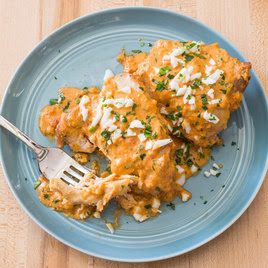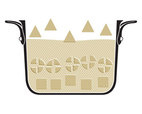Why this recipe works:
For a homemade baguette that rivals the best from Parisian boulangeries,
we took a trip to France to learn firsthand what it takes. The problem
with most published recipes, we discovered, is that all the small
details that matter are glossed over. For an authentic wheaty flavor, we
add a bit of whole-wheat flour (sifted to remove some of the larger
pieces of bran that would otherwise add bitterness and make the loaf
dense) to the white flour. Mixing the dough in a machine and then using a
series of gentle folds to develop the dough creates the perfect tender,
irregular internal crumb. Next we employ a long, slow rise in the
refrigerator, which delivers the complex flavor of fermentation while
making the recipe flexible, since we can bake the loaves anytime within a
three-day window. To shape the loaves perfectly without overworking the
dough, we employ a multistep approach that gradually transforms them
into baguettes. Finally, we ensure a crispy, crackly crust by moistening
the couche, the pleated linen cloth that holds the loaves as
they proof, and by starting the loaves beneath a pair of upturned
disposable roasting pans to trap steam as it evaporates from the
exterior of the dough.
less
less
Makes four 15-inch-long baguettes
If you can’t find King Arthur all-purpose flour, substitute bread flour. For best results, weigh your ingredients. This recipe makes enough dough for four loaves, which can be baked anytime during the 24- to 72-hour window after placing the dough in the fridge. For tips on folding and slashing, see "Why Some Bread Doughs Are Folded" and "Slashing Rustic Loaves" under related content. It's essential to watch our video on making baguettes.Ingredients
- 1/4 cup (1 1/3 ounces) whole-wheat flour
- 3 cups (15 ounces) King Arthur all-purpose flour
- 1 1/2 teaspoon salt
- 1 teaspoon instant or rapid-rise yeast
- 1 teaspoon diastatic malt powder (optional)
- 1 1/2 cups (12 ounces) water
- 2 (16 by 12-inch) disposable aluminum roasting pans
Instructions
-
1. Sift whole-wheat flour through fine-mesh strainer into bowl of stand mixer; discard bran remaining in strainer. Add all-purpose flour, salt, yeast, and malt powder, if using, to mixer bowl. Fit stand mixer with dough hook, add water, and knead on low speed until cohesive dough forms and no dry flour remains, 5 to 7 minutes. Transfer dough to lightly oiled large bowl, cover with plastic wrap, and let rest at room temperature for 30 minutes.
2. Holding edge of dough with your fingertips, fold dough over itself by gently lifting and folding edge of dough toward center. Turn bowl 45 degrees; fold again. Turn bowl and fold dough 6 more times (total of 8 folds). Cover with plastic and let rise for 30 minutes. Repeat folding and rising every 30 minutes, 3 more times. After fourth set of folds, cover bowl tightly with plastic and refrigerate for at least 24 hours or up to 72 hours.
3. Transfer dough to lightly floured counter, pat into 8-inch square (do not deflate), and divide in half. Return 1 piece of dough to container, wrap tightly with plastic, and refrigerate (dough can be shaped and baked anytime within 72-hour window). Divide remaining dough in half crosswise, transfer to lightly floured rimmed baking sheet, and cover loosely with plastic. Let rest for 45 minutes.
4. On lightly floured counter, roll each piece of dough into loose 3- to 4-inch-long cylinder; return to floured baking sheet and cover with plastic. Let rest at room temperature for 30 minutes.
 5. Lightly mist underside of couche with water,
drape over inverted baking sheet, and dust with flour.
Gently press 1 piece of dough into 6 by 4-inch rectangle on lightly
floured counter, with long edge facing you. Fold upper quarter of dough
toward center and press gently to seal. Rotate dough 180 degrees and
repeat folding step to form 8 by 2-inch rectangle.
5. Lightly mist underside of couche with water,
drape over inverted baking sheet, and dust with flour.
Gently press 1 piece of dough into 6 by 4-inch rectangle on lightly
floured counter, with long edge facing you. Fold upper quarter of dough
toward center and press gently to seal. Rotate dough 180 degrees and
repeat folding step to form 8 by 2-inch rectangle.
 6. Fold dough in half toward you, using thumb of
your other hand to create crease along center of dough, sealing with
heel of your hand as you work your way along the loaf. Without pressing
down on loaf, use heel of your hand to reinforce seal (do not seal ends
of loaf).
6. Fold dough in half toward you, using thumb of
your other hand to create crease along center of dough, sealing with
heel of your hand as you work your way along the loaf. Without pressing
down on loaf, use heel of your hand to reinforce seal (do not seal ends
of loaf).
 7. Cup your hand over center of dough and roll dough back and forth gently to tighten (it should form dog-bone shape).
7. Cup your hand over center of dough and roll dough back and forth gently to tighten (it should form dog-bone shape).
 8. Starting at center of dough and working toward
ends, gently and evenly roll and stretch dough until it measures 15
inches long by 1 1/4 inches wide. Moving your hands in opposite
directions, use back and forth motion to roll ends of loaf under
your palms to form sharp points.
8. Starting at center of dough and working toward
ends, gently and evenly roll and stretch dough until it measures 15
inches long by 1 1/4 inches wide. Moving your hands in opposite
directions, use back and forth motion to roll ends of loaf under
your palms to form sharp points.
 9. Transfer dough to floured couche, seam side up.
On either side of loaf, pinch edges of couche into pleat, then cover
loosely with large plastic garbage bag.
9. Transfer dough to floured couche, seam side up.
On either side of loaf, pinch edges of couche into pleat, then cover
loosely with large plastic garbage bag.
 10. Repeat steps 4 through 9 with second piece of dough and place on opposite side of pleat. Fold
edges of couche over loaves to cover completely, then carefully place sheet inside bag, and tie or fold under to enclose.
10. Repeat steps 4 through 9 with second piece of dough and place on opposite side of pleat. Fold
edges of couche over loaves to cover completely, then carefully place sheet inside bag, and tie or fold under to enclose.
 11. Let stand until loaves have nearly doubled in
size and dough springs back minimally when poked gently with your
fingertip, 45 to 60 minutes. While bread rises, adjust oven rack to
middle position, place
baking stone on rack, and heat oven to 500 degrees.
11. Let stand until loaves have nearly doubled in
size and dough springs back minimally when poked gently with your
fingertip, 45 to 60 minutes. While bread rises, adjust oven rack to
middle position, place
baking stone on rack, and heat oven to 500 degrees.
 12. Line pizza peel with 16 by 12-inch piece of
parchment paper with long edge perpendicular to handle. Unfold couche,
pulling from ends to remove pleats. Gently pushing with side of flipping
board,
roll 1 loaf over, away from other loaf, so it is seam side down. Using
your hand, hold long edge of flipping board between loaf and couche at
45-degree angle, then lift couche with your other hand and flip loaf
seam side up onto board.
12. Line pizza peel with 16 by 12-inch piece of
parchment paper with long edge perpendicular to handle. Unfold couche,
pulling from ends to remove pleats. Gently pushing with side of flipping
board,
roll 1 loaf over, away from other loaf, so it is seam side down. Using
your hand, hold long edge of flipping board between loaf and couche at
45-degree angle, then lift couche with your other hand and flip loaf
seam side up onto board.
 13. Invert loaf onto parchment-lined peel, seam side
down, about 2 inches from long edge of parchment, then use flipping
board to straighten loaf. Repeat with remaining loaf, leaving at least 3
inches between loaves.
13. Invert loaf onto parchment-lined peel, seam side
down, about 2 inches from long edge of parchment, then use flipping
board to straighten loaf. Repeat with remaining loaf, leaving at least 3
inches between loaves.
 14. Holding lame concave side up at 30-degree angle
to loaf, make series of three 4-inch long, 1/2-inch-deep slashes along
length of loaf, using swift, fluid motion, overlapping each slash
slightly. Repeat with second loaf.
14. Holding lame concave side up at 30-degree angle
to loaf, make series of three 4-inch long, 1/2-inch-deep slashes along
length of loaf, using swift, fluid motion, overlapping each slash
slightly. Repeat with second loaf.
 15. Transfer loaves, on parchment, to baking
stone, cover with stacked inverted disposable pans, and bake for 5
minutes. Carefully remove pans and bake until loaves are evenly browned,
12 to 15 minutes longer, rotating parchment halfway through baking.
Transfer to cooling rack and let cool for at least 20 minutes before
serving. Consume within 4 hours.
15. Transfer loaves, on parchment, to baking
stone, cover with stacked inverted disposable pans, and bake for 5
minutes. Carefully remove pans and bake until loaves are evenly browned,
12 to 15 minutes longer, rotating parchment halfway through baking.
Transfer to cooling rack and let cool for at least 20 minutes before
serving. Consume within 4 hours.

Technique
Making Parisian Quality Baguettes
Gentle shaping is key for authentic texture. For the best flavor, here’s what we do:
- Add some whole-wheat flour to mimic the wheatiness of French flours
- Use a long, cold fermentation to develop complex flavor
- Steam the loaves under aluminum pans to create a dark and flavorful crispy crust
Baguette Baker’s Kit
Baguettes require a few specialty items, though
we did find some alternatives. (You’ll also need
a pizza peel and a baking stone.)
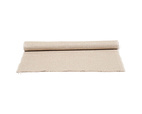
COUCHE: To proof baguettes, bakers use a heavy linen
couche. It maintains the loaves’ shape while wicking away moisture, and
the fabric easily releases the dough. Our favorite is the San Francisco
Baking Institute 18" Linen Canvas (Couche) ($8 for a 36 by 18-inch
couche). Alternatively, use a double layer of 100 percent linen tea
towels at least 16 inches long and 12 inches wide.

FLIPPING BOARD: To move baguettes from the couche to
the oven, professional bakers use a flipping board ($12 from
Breadtopia; see an example in the steps in the instructions). A homemade
substitute, made by taping two 16 by 4-inch pieces of heavy cardboard
together with packaging tape, works equally well.
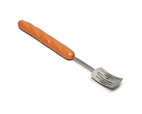
LAME: For the proper almond-shaped slashes, with one
edge that bakes up into a crispy ridge, you must cut the loaf at a low
angle, something much more easily done with the curved blade of a lame.
Our favorite, the Breadtopia Bread Lame ($9.50), scored baguettes
perfectly (we did have to choke up a bit on the long handle), and its
blades are easy to change (it came with five extras). Alternatively, an
unused box cutter blade will work.
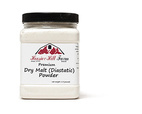
DIASTATIC MALT POWDER: During the long proofing
time, nearly all the sugars in this dough are consumed by the yeast.
Since sugars are responsible for browning and caramelization, this will
leave the crust pale and dull-tasting. Adding diastatic malt powder,
derived from a naturally occurring enzyme that converts the starches in
flour into sugar, guarantees a supply of sugar at baking time and thus a
crust that browns and caramelizes.
Purchase diastatic malt powder (available from Amazon, $7.63 for 1
pound), not plain malt powder or malt syrup.



